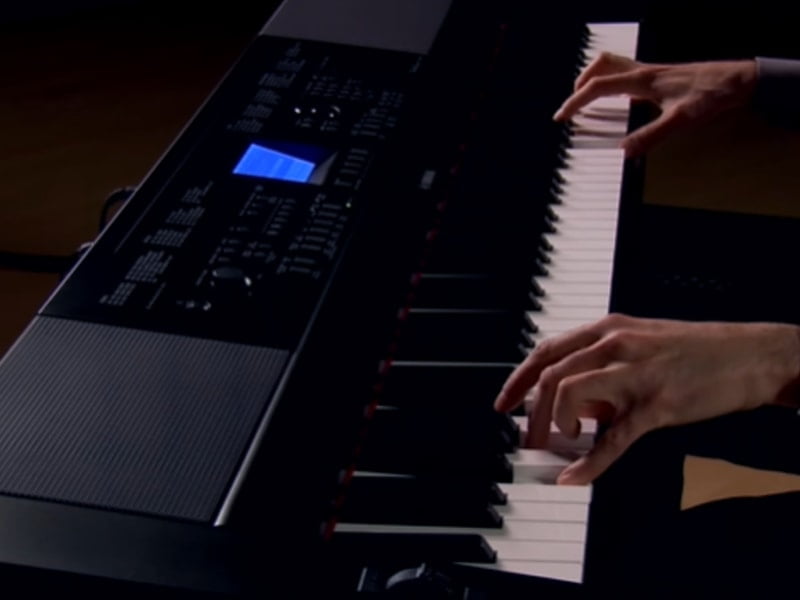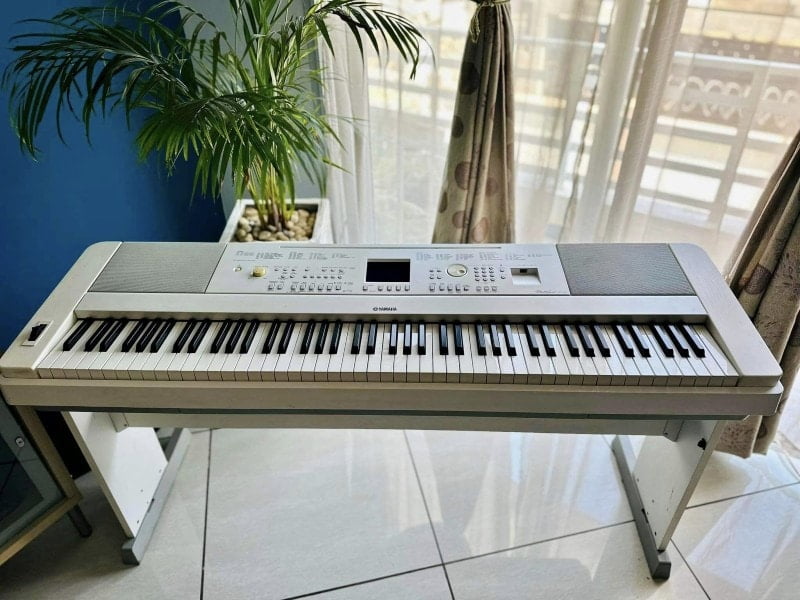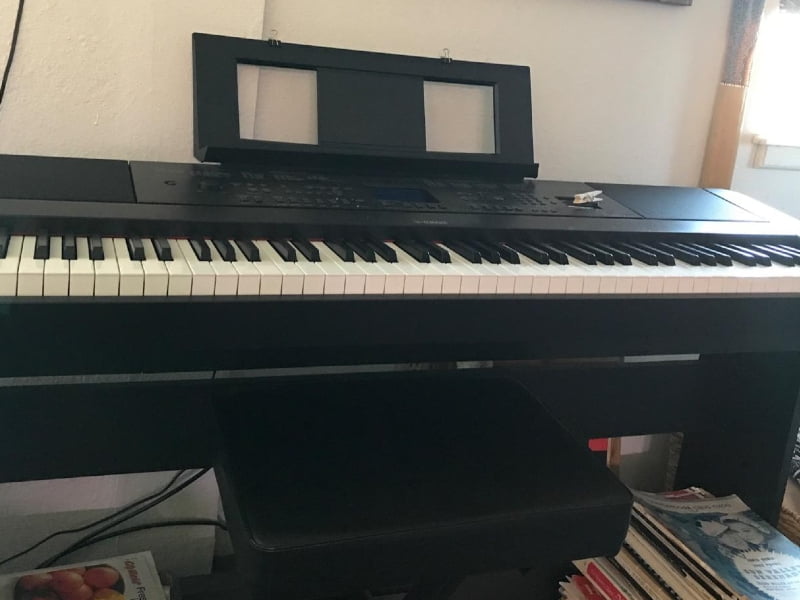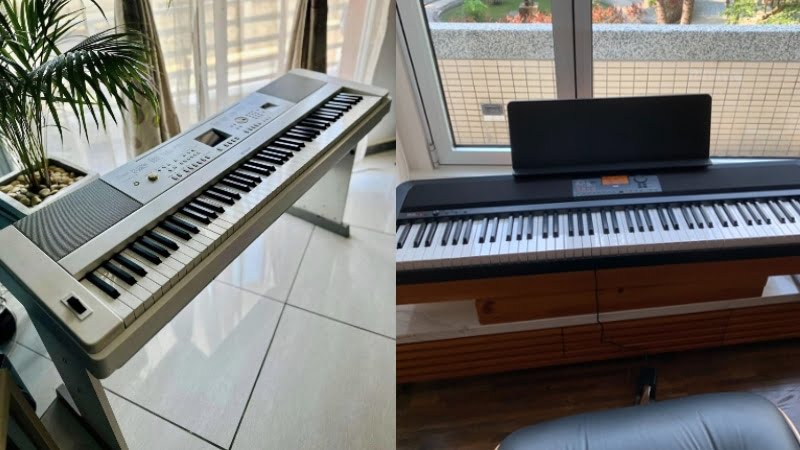In this Korg XE-20 vs Yamaha DGX-660 review, we’ll find out which arranger piano offers the best value for the money and which one would be the better pick for you!
I was more than ready to make this Korg XE-20 vs Yamaha DGX-660 comparison. Since these are two very affordable arranger pianos that offer various features, comparing them was a whole lot of fun.
And while I would recommend either option for anyone looking for a versatile and high-quality instrument, I have to admit that the Yamaha DGX-660 holds a slight edge. This is because the Yamaha DGX-660 has a much more realistic feel and higher-quality sounds, which are two things that you need to prioritize when buying an arranger piano.
That said, the Korg XE-20 is still a great digital piano. While it fell slightly short of the Yamaha DGX-660, it offers tons of piano features and is more than enough to satisfy the needs of any pianist.
If you’re on the fence regarding which piano is the best fit for you, you’ve come to the right place. Below, I’ll be giving a detailed comparison of both pianos so that you won’t have a hard time choosing between the two.
Korg XE-20 vs Yamaha DGX-660: Comparison Chart




Last update on 2025-07-11 / Affiliate links / Images from Amazon Product Advertising API
Korg XE-20 vs Yamaha DGX-660: A Head-to-Head Comparison
There were three main categories I considered when comparing these two pianos, these were the tone, feel, and the piano features. These are what I consider the most important characteristics of a digital piano, and trust me when I say that the Korg XE-20 and the Yamaha DGX-660 delivered on all three categories.
That said, Yamaha edged out a slight win with a score of 2-1. So, as you can tell, it was a very close fight. Below, I’ll explain exactly how the Yamaha DGX-660 got its two points and the one characteristic where I found the Korg XE-20 to be the superior pick.
Tone
The winner: Yamaha DGX-660
Whenever you buy a digital piano, your first question is always how it sounds. So, the first characteristic I analyzed was the tone of both pianos. And as expected, they both sounded great and came with a wide selection of sounds. But even if the Korg XE-20 has a wider sound library, there was no denying that the Yamaha had a superior tone. And because of that, the Yamaha DGX-660 ended up taking the point.

+Tone Generation
There is nothing wrong with the Korg’s tone generator. It features the Stereo PCM engine that comes from the Korg brand and is one of the best available. When testing the pianos, I instantly fell in love with the piano tones. In fact, there was one specific piano tone -the Italian piano – that I found to be the best and would probably be very at home at a premium stage piano.
That said, even if the Stereo PCM generator is great, it still fell short of the Yamaha DGX-660’s piano tones. This is because the DGX-660 relies on the Pure CF Sound Engine, which aims to replicate the exact sound of the Yamaha CF Grand Pianos, which are some of the most popular grand pianos available.
Because of this, the Yamaha sounds much crisper and brighter than the Korg. Even if the Korg’s tones were very realistic, the Yamaha’s voices were undeniably more detailed, which is why I believe the Yamaha deserved the point when comparing tones.
+Sound Library
The Korg XE-20 has a wider sound library than the Yamaha DGX-660. This means that it features more voices as it comes with more than 700 tones. That said, not all of these voices come from the Stereo PCM generator, so there’s an obvious dip in quality with some voices.
Sadly, this is also the case for the Yamaha. It features over 500 voices, but not all of them are as realistic as the tones you get with the Pure CF Sound Engine.
Granted, you will definitely find a way to use these voices. For example, if you have to play various styles of music, all this variety is great. However, if you’re looking to record high-quality digital keyboard sounds with either option, you might find that the quality isn’t the best.
But for the price, I would still definitely say that both pianos offer a lot of value for the money based on tone alone.
Feel
The winner: Yamaha DGX-660
The next comparison point I had was the piano feel. This refers to how close to an acoustic piano these digital pianos feel. I had a lot of fun with this comparison point as both pianos feature great hammer action systems. But yet again, the Yamaha DGX-660 comes out on top but by a very narrow margin.

+Hammer Action
If you’re familiar with Yamaha digital pianos there’s a chance you already know the hammer action system on the DGX-660. Like many Yamaha options in this price range, the DGX-660 uses the Graded Hammer Standard or GHS. This is largely considered one of the best affordable hammer action systems on the market and definitely stands out compared to other models.
This is because the Graded Hammer Standard strikes a great balance between weight and the spring back. While the keys don’t spring back as well as they do on an acoustic piano or on higher-end digital pianos, they do have a much better feel than other affordable hammer action systems.
On top of that, the keys have a graded action. This means that the lower end of the piano features significantly heavier keys than the higher end. The result is a more realistic weight when you play, which is one of the reasons I love the DGX-660.
The Korg XE-20 features naturally weighted hammer action. This means that you still get the graded weight as on the DGX-660, but it’s definitely not as realistic as the Graded Hammer Standard.
Both pianos feature plastic keys that don’t have that much texture on them, which is expected at this price range. But if either model had textured or wooden keys, they would have easily won this comparison.
Piano Features
The winner: Korg XE-20
The one category where the Korg won out over the Yamaha was in the piano features. While both pianos feature a wide array of effects and playing modes as you would expect from arranger pianos, they have different polyphony. And since the Korg has much better polyphony than the Yamaha, it won this point.
+Polyphony
Polyphony is the piano’s ability to play simultaneous notes. Since the Korg XE-20 features 256-note polyphony, it can play many samples at the same time. So, whether you want to press all the piano keys at once or if you want the notes to ring out longer when you engage the sustain pedal, the Korg is the better pick.
The Yamaha only features 196-note polyphony. While this is more than decent, it still falls short of the Korg XE-20.
This high polyphony comes in handy when you’re blending two voices together (a feature available on both pianos). This makes the Korg a bit more versatile than the Yamaha, even if I found that the Yamaha has a more realistic feel and better tones.

Korg XE-20 vs Yamaha DGX-660: The Similarities
Just because these pianos come from different brands doesn’t mean that they don’t share any features. In fact, you might be surprised to learn that both pianos share a fair amount of similarities.
To start, let’s look at the playing modes. Since these are both arranger pianos designed to be used at live gigs and performances, they come with many playing modes. You can either split the piano into two zones with their own voice (split mode), blend two voices (dual mode), or even turn the piano into two mini keyboards with the same voice (lesson or duo mode).
This is one of the reasons these pianos are great for performers. Aside from having a realistic feel and various features, these pianos are very versatile. Whether you’re playing rock, pop, or classical music these pianos have the voices and playing modes to suit your style.
Quick Rundown of the Yamaha DGX-660
- The Pure CF Sound Engine faithfully reproduces the tone of a meticulously sampled and highly acclaimed Yamaha concert grand piano
- GHS weighted action is heavier in the low register and lighter in the high, just like an acoustic piano
- Score display puts music notation of MIDI songs on the screen, helping you play your favorites by following the bouncing ball
- The Piano room lets you choose from a variety of pianos and acoustic settings to create your own personal piano environment
- The 6 track recorder allows you to capture your performances and song ideas, then add additional layers to spice up your pieces
Last update on 2025-07-11 / Affiliate links / Images from Amazon Product Advertising API
Quick Rundown of the Korg XE-20
- 88-key Digital Ensemble Piano with Hammer Action
- 280 Accompaniment Styles
- Built-in Speaker System
- Arranger Functionality
- 705+ Sounds
Last update on 2025-07-11 / Affiliate links / Images from Amazon Product Advertising API
Product Video
Related Articles to Yamaha Dgx 660
- Yamaha YDP-164 vs DGX-660: Why You Should Go for the DGX-660
- Yamaha DGX-660 vs Roland FP-90: Why the Roland FP-90 Is the Better Pick
- Yamaha DGX-530 vs 660: Why the DGX-660 Is the Better Pick
- Yamaha DGX-505 vs 660: Why the DGX-660 Is the Better Pick
- Yamaha DGX-660 vs DGX-640: A DGX Comparison
- Yamaha DGX-660 vs DGX-630: A DGX Comparison
- Yamaha DGX-620 vs 660: Finding the Best DGX Model
- Yamaha DGX-660 vs YDP-163: Which Is the Better Piano?
- Yamaha DGX-660 vs Roland Juno DS-88: Which Is the Better Piano?
- Yamaha DGX-660 vs Casio PX-360: Which Is the Better Piano?
- Yamaha DGX-660 vs YDP-144: Which Is the Better Yamaha Piano?
- Yamaha DGX-660 vs Korg Havian 30: Which Is the Better Digital Piano?
- Yamaha DGX-660 vs Casio CGP-700: Which Is the Better Pick?
- Yamaha DGX-660 vs YPG-535: Finding the Best Yamaha Digital Piano
- Yamaha DGX-660 vs P515: Is the P515 Worth the Extra Cost?
- Yamaha DGX-660 vs P-115: Which Yamaha Model Is Better?
- Yamaha DGX-660 vs Casio PX-560: Which Piano Offers More Value For The Money
- Yamaha DGX-660 vs 650: A DGX Comparison
- Yamaha P45 Vs DGX-660: A Head-to-Head Comparison
- Yamaha DGX 670 Vs 660: The Distinct Difference In Details You Need To Know About
- Yamaha YDP-103 Vs DGX-660: Which Is The Better Yamaha Piano?
- Casio PX-770 Vs Yamaha DGX-660: Should You Get A Portable Or Console Digital Piano?
- Yamaha P71 vs DGX-660: Can the Amazon Exclusive Beat Out the Premium Model?
- Yamaha P125 vs DGX 660 Comparison: Can the P125 Hold Its Own Against the DGX 660?
References:
- Yamaha DGX-660: https://europe.yamaha.com/en/products/musical_instruments/pianos/portable_grand/dgx-660/specs.htmlv
- Korg XE-20: https://www.korg.com/ph/products/digitalpianos/xe20/specifications.php
Lulacruza is an electronic folk duo operating at the junction of the hypermodern and the ancient. Our music weaves together hypnotic female singing, South American folk instruments and electronic processing, while channeling pulsating waves from the source of creation.
Lalucruza is also a community where you can connect with other music lovers to collaborate, exchange ideas and share knowledge. A platform for who wants to learns the basics of playing piano, guitar, drum masters’ technique, etc.. is the premise of our website.
